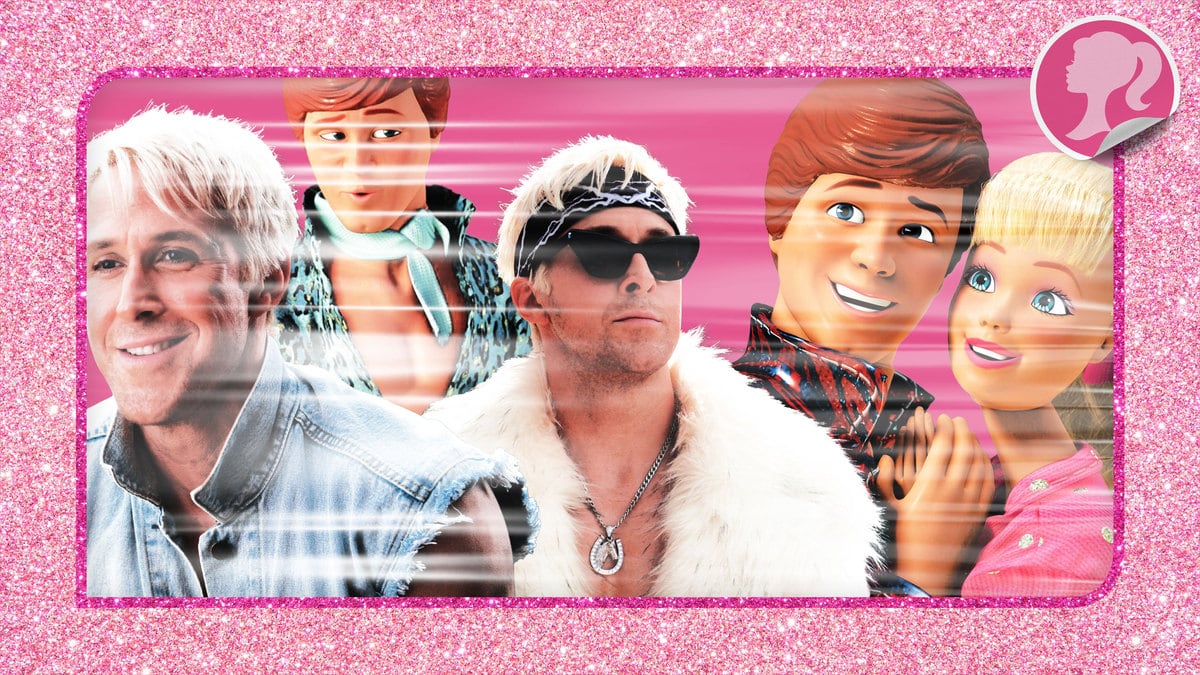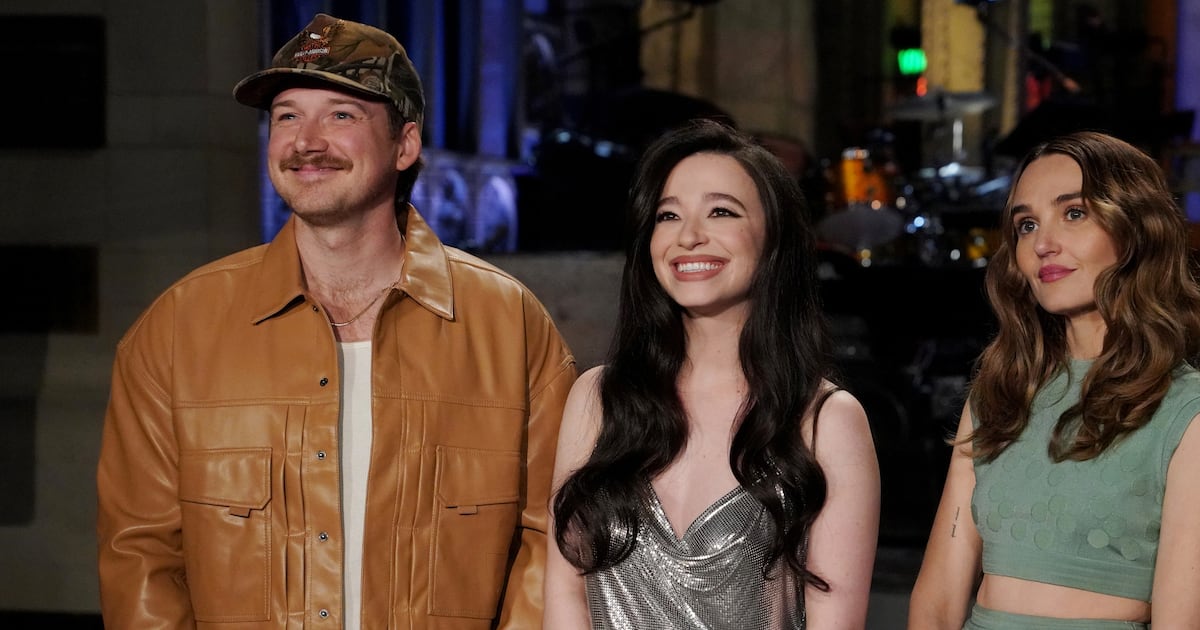It’s Barbie Week at The Daily Beast’s Obsessed, celebrating the doll’s pop-culture history, our favorite Barbie memories, and a certain major movie. Read all of our coverage here!
“She’s everything. He’s just Ken.” That’s the tagline for the wildly anticipated Barbie movie, directed by Greta Gerwig and starring Margot Robbie and Ryan Gosling. The implication is clear: Come for Barbie, and stay for Barbie… but Ken happens to be there too.
Ken has long been seen as nothing but Barbie’s human accessory, but it wasn’t always this way for the poor misunderstood doll. When Ken was first introduced in 1961, his first commercial tried to position him as Barbie’s equal and, unmistakably, boyfriend. “Get both Barbie and Ken and see where the romance will lead!” the commercial promised.
Since then, like Barbie, Ken has undergone countless transformations and fashions. But as time went on, Ken found himself an afterthought. Toymakers Mattel never gave him the same kind of backstories as Barbie—while she’s had over 200 careers, Ken has had just some 40-odd professions. (An incredible amount of jobs for a person, sure. But for a doll? Embarrassing.)
Barbie has starred in lots of video games and more than three dozen films; Ken has had a major role in a mere handful of them. But there’s one key reason why Ken is always lagging significantly behind Barbie and it's a lot deeper than the doll’s seeming lack of popularity: Ken has been miscast. He’s not Barbie’s boyfriend. He’s Barbie’s gay best friend.
Despite Mattel’s insistence that Barbie and Ken are in a happy romantic relationship, there’s plenty of speculation about Ken’s sexuality. Even if his makers claim him to be straight, there’s mounting proof to the contrary. Perhaps the most indisputable evidence that Ken is in fact both a member of the queer community and Barbie’s bestie, not boy toy, comes from a rather surprising place: 2010’s Toy Story 3.
In Toy Story 3, Barbie and Ken play a surprisingly large role. Their introduction to the film is tinged with romantic tension. When the pair meet, the film invokes a common trope: a romantic needle drop hits the moment the lovers lock eyes. In this case, it’s “Dream Weaver” by Gary Wright. As far as Barbie and Ken are concerned, they’re the only ones in the room. “I love your leg warmers!” Ken tells Barbie. “Nice ascot,” she banters, with heavy emphasis on the first syllable. Before things get too heated, they lock arms and walk off together.

Let’s be honest—despite the romantic overtones of the scene, their brief exchange tells us everything about how they see each other. Ken doesn’t mention anything about Barbie’s body, instead highlighting her leg warmers. But Barbie is unsubtly trying to seduce Ken in just two words. She’s after Ken, but Ken is after someone whose clothes he can admire.
Sure, later in the film, Ken and Barbie say “I love you” to each other. And they go back and forth between saying each word of “I love you”—so someone different can say “love” each time, as Ken explains. He mentions offhand that he has everything except someone to share it with. Barbie and Ken even nuzzle their noses together. Yes, there’s definitely love between friends—but through it all, there’s not a hint of sexual chemistry.
Look, I know what you’re thinking—Sir, this is Toy Story; what exactly are you expecting? If you look at other romances in the franchise—Woody and Bo Peep, and Jesse and Buzz—there’s no doubt that there’s real love there between these sentient toys. Their passion for one another transcends more than simply being interested in each other’s outfits. The same cannot be said of the Mattel dolls. That’s made evident when Ken finally gets an opportunity for intimacy with Barbie. “This is where the magic happens,” he tells Barbie when they finally go to his DreamHouse together, having parents all over the world clutching their pearls. But fear not: Ken simply takes Barbie to… his walk-in wardrobe.
Any semblance of romance makes way for friendship, when the pair jubilantly peruse Ken’s outfits. And instead of doing something wild like kissing Barbie, Ken puts on a fashion show for her instead. The film won’t say it, but a post-credits punchline about Ken’s handwriting, complete with hearts and stars surrounding his name, tells us what we need to know.
The heavily implied nature of Ken’s gayness in Toy Story 3 harkens back to Hollywood’s traditional gay best friend-type characters. In the Hays Code era, explicit references to homosexuality weren’t allowed, so characters like Van Buren (Franklin Pangborn) in 1937’s Easy Living, Kip (David Wayne) in 1949’s Adam’s Rib, or Addison (George Sanders) in 1950’s All About Eve instead were imbued with effeminate characteristics, offering a glimpse outside of heteronormativity without explicitly being queer.
None of these characters were the same—some were catty, others sweet. Some had ulterior motives, and others offered unconditional support. But each of the gay best friends was intrinsically defined by their relationships with their straight friends. We never really learned much about them as individuals. They lived on the margins, fleshing out their straight counterparts, hardly having a purpose without them; that portrayal remains true today.

Decades later, in 2010, the gay best friend was all the rage; Teen Vogue even went so far as to proclaim the GBF as the summer’s must-have accessory. But unlike in the first half of the 20th century, in today’s cinema, the GBF is allowed to be openly gay. At the same time, they still barely register as people with character traits beyond their relationships with their straight counterparts. In movies like Mean Girls (2004), The Devil Wears Prada (2006), Easy A (2010), No Strings Attached (2011), and Isn’t It Romantic (2019), gay friends exist entirely in the orbit of their female friends. It’s such a strong trope that it even persists in queer romantic comedies: 2020’s Happiest Season finds John (Dan Levy) offering advice and snarky one-liners to his lesbian bestie in lieu of meaningful character development.
In Toy Story 3, the same is true of Ken. His existence depends on and circulates around Barbie. In Barbie, Ken has found someone who really understands him. He doesn’t get along with the other toys, who mock him for being a “girl's toy.” But Barbie loves fashion, just like he does. “No one appreciates clothes here, Barbie,” Ken laments to Barbie, about the other toys’ treatment of him. “No one!” But Barbie does, and for Ken, that’s life-changing.
There are plenty of reasons why the film wouldn’t outrightly state that Ken is homosexual. Not only does Disney itself have a complicated history with queer characters, but Ken and Barbie are also the property of Mattel, which has always been steadfast in asserting Ken’s heterosexuality. That’s never been clearer than in 1993 when the toy company tried to reignite Ken’s popularity Mattel’s solution? Earring Magic Ken.
Earring Magic Ken was a fiercer, infinitely more queer Ken than ever before. This version of the doll had bleached blonde hair, a purple leather vest (!), a pink-purple mesh top (!!), and of course, and earring in the “gay ear”. But that’s not all: Around Ken’s neck was something that any active participant of the queer scene in the ’90s recognized instantly—a cock ring (!!!).
The Earring Magic Ken turned Barbie’s boyfriend into an out-and-proud homosexual raver. Mattel, of course, vehemently denied any claims that Ken was gay, let alone that he had something as preposterous as a cock ring around his neck. As Lisa McKendall, former manager of marketing and communications, said in an interview about the doll, “We’re not in the business of putting cock rings into the hands of little girls.”
Regardless of Mattel’s intentions, it’s hard to deny what the eye can see. Despite the name, cock rings at the time were used as a fashion accessory and a sign of defiant queerness and sex positivity. As a result, gay men bought the doll in droves, and despite Mattel ultimately recalling the doll and wiping away any trace of Earring Magic Ken, it was near-impossible to see Ken as anything but the glorious homosexual he was born to be from then on. Mattel spent the next couple of decades trying to retain Ken’s more heteronormative, masculine image, but the veil was lifted, and there was no going back.

Though Mattel doesn’t seem to be willing to say Ken is actually gay, the Ken dolls of recent years seem to really lean into Ken’s queerness. The yassification of Ken is clearly underway. While there is no way to “dress gay,” there are several dolls that seem to suggest otherwise, such as:
- Fashionista Ken #193, who looks very excited to tell you about his new obsession, Troye Sivan;
- Travel Ken Doll, who has a satchel perfect for bathhouses and a purple overnight bag that literally proclaims he’s “extra;”
- Ken Looks Doll, serving “I’m gonna give you a makeover”-type realness while sporting black pleather pants;
- This Ken, who wears the least heterosexual double denim imaginable.
While I have a feeling the new Barbie movie will put in the work to convince us that Ken is a hetero dude who loves nothing in life more than Barbie herself, the writing’s already on the wall: Ken is, and always will be, Barbie’s gay best friend.
Keep obsessing! Sign up for the Daily Beast’s Obsessed newsletter and follow us on Facebook, Twitter, Instagram and TikTok.
Read more of our Barbie coverage HERE.






